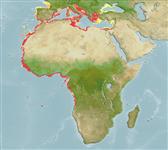Environment: milieu / climate zone / Tiefenbereich / distribution range
Ökologie
seewasser; brackwasser benthopelagisch; ozeanodrom (Ref. 3688); tiefenbereich 1 - 200 m (Ref. 4781), usually 30 - 50 m (Ref. 2683). Subtropical; 45°N - 17°S, 19°W - 36°E
Eastern Atlantic: Portugal and Strait of Gibraltar to Angola, including the Mediterranean.
Length at first maturity / Size / Gewicht / Alter
Geschlechtsreife: Lm 18.7, range 17 - 23 cm
Max length : 90.0 cm SL Männchen/unbestimmt; (Ref. 4781); common length : 50.0 cm SL Männchen/unbestimmt; (Ref. 4781); max. veröff. Gewicht: 11.6 kg (Ref. 40637)
Generally found in hard bottoms (rocks and rubble), the older individuals in the deeper part of the range, the young in inshore areas. Feed mainly on bivalves and also on crustaceans and fish. Sexual maturity at 2 years old. Spawning migration occurs parallel to the coast with intermittent spawning between spring and autumn over soft bottoms in shallow waters (Ref. 3688).
A different diagnosis of sexual pattern may arise for this species brought about by geographical variations (Ref. 103751). Also Ref. 41163.
Bauchot, M.-L. and J.-C. Hureau, 1990. Sparidae. p. 790-812. In J.C. Quero, J.C. Hureau, C. Karrer, A. Post and L. Saldanha (eds.) Check-list of the fishes of the eastern tropical Atlantic (CLOFETA). JNICT, Lisbon; SEI, Paris; and UNESCO, Paris. Vol. 2. (Ref. 3688)
IUCN Rote Liste Status (Ref. 130435: Version 2025-1)
Bedrohung für Menschen
Harmless
Nutzung durch Menschen
Fischereien: kommerziell; Sportfisch: ja
Tools
Zusatzinformationen
Download XML
Internet Quellen
Estimates based on models
Preferred temperature (Ref.
123201): 13.3 - 25.2, mean 17.5 °C (based on 97 cells).
Phylogenetic diversity index (Ref.
82804): PD
50 = 0.5156 [Uniqueness, from 0.5 = low to 2.0 = high].
Bayesian length-weight: a=0.02042 (0.01731 - 0.02408), b=2.94 (2.89 - 2.99), in cm total length, based on LWR estimates for this species (Ref.
93245).
Trophic level (Ref.
69278): 3.7 ±0.54 se; based on food items.
Generation time: 5.3 ( na - na) years. Estimated as median ln(3)/K based on 1
growth studies.
Widerstandsfähigkeit (Ref.
120179): mittel, Verdopplung der Population dauert 1,4 - 4,4 Jahre. (K=0.28; tmax=10; tm=2).
Fishing Vulnerability (Ref.
59153): Moderate to high vulnerability (46 of 100).
🛈
Climate Vulnerability (Ref.
125649): Moderate to high vulnerability (54 of 100).
🛈
Nutrients (Ref.
124155): Calcium = 37.1 [17.3, 70.3] mg/100g; Iron = 1.04 [0.30, 2.90] mg/100g; Protein = 19.7 [18.1, 21.3] %; Omega3 = 0.253 [0.138, 0.453] g/100g; Selenium = 39 [17, 80] μg/100g; VitaminA = 7.42 [1.82, 28.09] μg/100g; Zinc = 0.592 [0.297, 1.251] mg/100g (wet weight); based on
nutrient studies.
